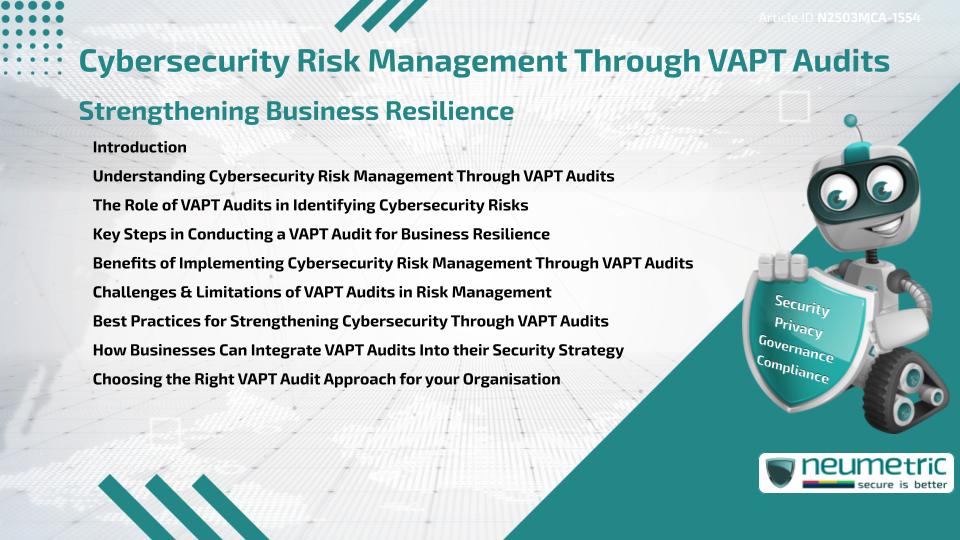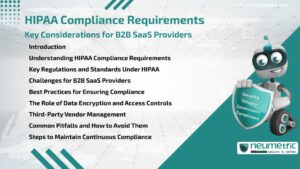Table of Contents
ToggleIntroduction
In today’s digital landscape, businesses face increasing threats from cyberattacks that can compromise Sensitive Data, disrupt operations & damage reputation. Cybersecurity Risk Management through VAPT audits plays a crucial role in identifying Vulnerabilities & ensuring robust Security Measures. By implementing a proactive approach, Organisations can mitigate Risks & strengthen their overall security posture.
Understanding Cybersecurity Risk Management Through VAPT Audits
Cybersecurity Risk Management through VAPT audits involves a structured assessment of security Vulnerabilities in an Organisation’s IT infrastructure. These audits help detect potential weaknesses & assess the overall resilience of systems against Cyber Threats. By combining Vulnerability assessments with Penetration Testing, businesses gain a comprehensive view of their security landscape.
The Role of VAPT Audits in Identifying Cybersecurity Risks
VAPT audits serve as a critical tool in identifying Security Gaps that could be exploited by cybercriminals. By simulating real-world attacks, Penetration Testing evaluates system defenses, while Vulnerability assessments highlight weaknesses that require remediation. This dual approach enables Organisations to address security flaws before they are exploited.
Key Steps in Conducting a VAPT Audit for Business Resilience
- Defining the Scope – Identifying assets, systems & networks to be assessed.
- Performing a Vulnerability Assessment – Scanning for known Vulnerabilities & Security Gaps.
- Conducting Penetration Testing – Simulating attacks to test the effectiveness of Security Controls.
- Analyzing Findings – Evaluating detected Vulnerabilities & their impact on Business Operations.
- Providing Remediation Strategies – Offering actionable recommendations to mitigate Risks.
- Generating Reports – Documenting the Audit Findings & security improvements.
Benefits of Implementing Cybersecurity Risk Management Through VAPT Audits
- Early Threat Detection – Identifies security weaknesses before they are exploited.
- Regulatory Compliance – Helps meet security requirements for standards such as GDPR, HIPAA & ISO 27001.
- Enhanced Incident Response – Improves readiness to address security breaches.
- Protection Against Financial Loss – Reduces costs associated with data breaches & cyber incidents.
- Improved Stakeholder Trust – Strengthens Customer & partner confidence in business security practices.
Challenges & Limitations of VAPT Audits in Risk Management
While VAPT audits provide valuable insights, they also come with certain limitations:
- Resource Intensity – Requires skilled professionals & advanced tools.
- Frequent Updates Needed – Cyber Threats evolve rapidly, demanding continuous assessments.
- Potential Disruptions – Improperly conducted penetration tests can impact system performance.
- False Positives – Some Vulnerability scanners may report non-critical issues, requiring further analysis.
Best Practices for Strengthening Cybersecurity Through VAPT Audits
- Schedule regular Audits – Conduct VAPT assessments periodically to stay ahead of Threats.
- Use a Risk-Based Approach – prioritise testing Critical Assets & high-Risk areas.
- Employ Skilled Professionals – Work with certified security experts to perform accurate assessments.
- Remediate Identified Vulnerabilities Promptly – Address Security Gaps as soon as they are detected.
- Maintain Compliance with Industry Standards – Align audits with regulatory & Compliance Requirements.
How Businesses Can Integrate VAPT Audits Into their Security Strategy
To enhance Cybersecurity Risk Management through VAPT audits, Organisations should incorporate these audits into their broader Security Framework. This includes:
- Embedding VAPT audits within ongoing Risk Management processes.
- Aligning Audit strategies with Business Objectives & Compliance needs.
- Educating Employees on Cybersecurity Best Practices & Threat awareness.
Choosing the Right VAPT Audit Approach for your Organisation
Selecting the right VAPT Audit approach depends on business size, industry & security needs. Organisations should consider:
- Internal vs. External Audits – Internal audits provide routine assessments, while external audits offer unbiased evaluations.
- Automated vs. Manual Testing – Automated tools can quickly identify Vulnerabilities, while manual testing provides in-depth analysis.
- Continuous Monitoring – Implementing ongoing Security Assessments for real-time Threat detection.
Conclusion
Cybersecurity Risk Management through VAPT audits is essential for businesses aiming to safeguard their digital assets & maintain resilience against evolving Cyber Threats. By proactively identifying & addressing security Vulnerabilities, Organisations can enhance Compliance, reduce Risks & build stronger defenses. While challenges exist, adopting Best Practices & integrating VAPT audits into a comprehensive security strategy ensures long-term protection & Business Continuity.
Takeaways
- Cybersecurity Risk Management through VAPT audits helps businesses detect & mitigate security Threats effectively.
- VAPT audits enhance Regulatory Compliance, Incident Response & Stakeholder trust.
- Challenges such as resource demands & false positives should be addressed with proper planning.
- Businesses should integrate VAPT audits into their Security Framework to improve resilience against Cyber Threats.
- Choosing the right VAPT Audit approach ensures an effective & efficient security assessment strategy.
FAQ
What is Cybersecurity Risk Management through VAPT audits?
Cybersecurity Risk Management through VAPT audits involves identifying, assessing & mitigating security Risks in an Organisation’s IT infrastructure to enhance resilience against Cyber Threats.
How often should businesses conduct VAPT audits?
Businesses should perform VAPT audits regularly, at least once or twice a year & whenever significant changes occur in their IT infrastructure.
What is the difference between Vulnerability assessment & Penetration Testing?
Vulnerability assessment identifies Security Gaps, while Penetration Testing actively exploits those Vulnerabilities to evaluate the effectiveness of security defenses.
Can Small Businesses benefit from VAPT audits?
Yes, Small Businesses can use VAPT audits to protect Sensitive Data, comply with regulations & prevent Cyber Threats.
Are automated VAPT tools effective for Cybersecurity Risk Management?
Automated tools are useful for identifying known Vulnerabilities, but manual testing provides a more in-depth analysis of complex Security Threats.
What industries require VAPT audits?
Industries such as Finance, Healthcare, e-commerce & SaaS benefit from VAPT audits due to Regulatory Compliance & Cybersecurity concerns.
How do VAPT audits support Regulatory Compliance?
VAPT audits help Organisations meet security requirements for GDPR, HIPAA, ISO 27001 & other industry-specific standards.
What are the common limitations of VAPT audits?
Some limitations include resource intensity, frequent updates required, potential system disruptions & false positives from automated scans.
How can Organisations ensure the effectiveness of VAPT audits?
Organisations can ensure effectiveness by conducting audits regularly, working with skilled professionals, addressing Vulnerabilities promptly & integrating audits into their Cybersecurity strategy.
Need help?
Neumetric provides organisations the necessary help to achieve their Cybersecurity, Compliance, Governance, Privacy, Certifications & Pentesting goals.
Organisations & Businesses, specifically those which provide SaaS & AI Solutions, usually need a Cybersecurity Partner for meeting & maintaining the ongoing Security & Privacy needs & requirements of their Clients & Customers.
SOC 2, ISO 27001, ISO 42001, NIST, HIPAA, HECVAT, EU GDPR are some of the Frameworks that are served by Fusion – a centralised, automated, AI-enabled SaaS Solution created & managed by Neumetric.
Reach out to us!





